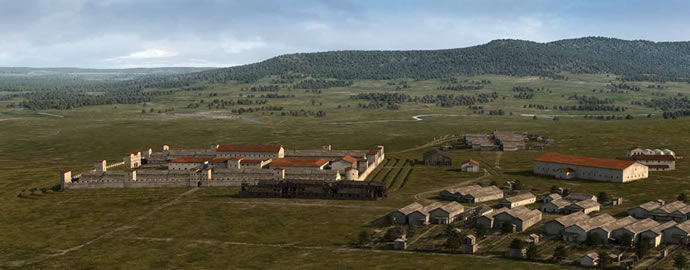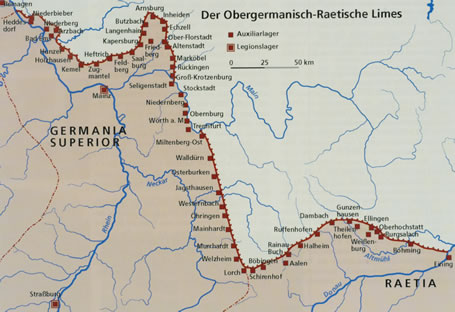Ruffenhofen and the German Frontier
 Virtual reconstruction of the fort and vicus at Ruffenhofen, looking north-east (virtual reconstruction Copyright Faber Courtial)
Virtual reconstruction of the fort and vicus at Ruffenhofen, looking north-east (virtual reconstruction Copyright Faber Courtial)
In Germany, the ca. 550 Km long Upper German-Raetian Limes (Obergermanisch-Raetischer Limes, abbreviated ORL) formed the border of the Roman Empire in the provinces of Upper Germania and Raetia. It advanced in several stages, with the outermost defences being built in the reign of Antoninus Pius (AD 138-161). These now form part of the World Heritage Site.
In the beginning, this border was secured only by a series of wooden watch towers located along a patrolled pathway. These were supported by timber and earthwork forts spaced at greater intervals (ca. 10-15 km) along a roadway paralleling the Limes.
 Map of the Upper German-Raetian LimesUnder Emperor Hadrian (AD 117-138) the border was closed with the help of a palisade wall. Shortly after this, the wooden watch towers and forts were replaced with stone structures. Towards the end of the second century AD., the wooden palisade in Raetia was replaced by a 3-4 m high stone wall – the so called “Raetian Wall“.
Map of the Upper German-Raetian LimesUnder Emperor Hadrian (AD 117-138) the border was closed with the help of a palisade wall. Shortly after this, the wooden watch towers and forts were replaced with stone structures. Towards the end of the second century AD., the wooden palisade in Raetia was replaced by a 3-4 m high stone wall – the so called “Raetian Wall“.
The Limes in the Hesselberg region
The Limes in the Heselberg area begins at the western state border with Baden-Württemberg near Mönchsroth and follows a general easterly direction. The course of the regional Limes coincides approximately with Sector 13 of the Reichs-Limes-Commission, which investigated the whole length of the German-Raetian Limes around 1900. The remains of 80 palisade posts were unearthed near Mönchsroth. In the forest between Weiltingen and Wilburgstetten, the “Raaetian Wall” rubble still reaches a height of 80 cm in some places. The ensuing section of the Limes takes on a northeasterly direction and crosses the Wörnitz river as well as 7 km of fields and meadows. In this area one finds the remains of a Roman fort at Ruffenhofen, as well as the Hesselberg, a dominant landscape feature. At the end of this stretch of the Limes, the direction changes back again towards the East.
The Roman fort at Ruffenhofen
The cavalry fort at Ruffenhofen was established around 110 AD and existed until about 260 AD. It lies on a flat rise where one would have had a view of a large local section of the Limes and its watch towers. Five hundred horsemen were stationed within the 3,7 hectares (1 ha = 10.000 square metres) of the fort. The names of the fort and of the original military contingent are still unknown.
Ruffenhofen is one of the few Limes forts with adjoining civilian settlements that has never been built over since Roman times. Only minor excavations were carried out in 1892 and 2005, so that major areas still remain undisturbed. Nevertheless, many details of the fort structures are known through aerial photography and extensive geophysical surveys.
Since 2003, 36 hectares have been taken out of agricultural use and designated as an archaeological reserve. This area includes the fort and part of the civilian settlement. The “Roman Park Ruffenhofen” is now open to the public. The Roman structures are marked by hedge rows and other temporary features.

